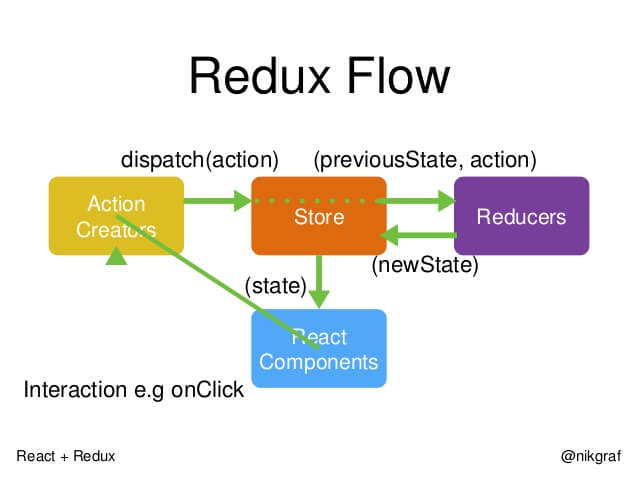一、设计思想
① Web 应用是一个状态机,视图与状态是一一对应的。
② 所有的状态,保存在一个对象里面。
二、基本概念和 API
1、Store
Store 是保存数据的地方,可以把它看成一个容器。整个应用只能有一个 Store。
Redux 提供 createStore 这个函数来生成 Store:
import { createStore } from 'redux'
const store = createStore(fn)
上面代码中,createStore 函数接受另一个函数作为参数,返回新生成的 Store 对象。
2、State
Store 对象包含所有数据,如果想得到某个时点的数据,可以通过 store.getState() 拿到,这里的 State 就是该时点 Store 的数据集合。
import { createStore } from 'redux'
const store = createStore(fn)
const state = store.getState()
3、Action
State 的变化,会导致 View 的变化。但用户接触不到 State,只能接触到 View。所以,State 的变化必须是 View 导致的。Action 就是 View 发出的通知,表示 State 应该要发生变化了。
Action 是一个对象。其中的 type 属性是必须的,表示 Action 的名称。其他属性可以自由设置,社区有一个规范可以参考。
const action = {
type: 'ADD_TODO',
payload: 'Learn Redux'
}
上面代码中,Action 的名称是 ADD_TODO,它携带的信息是字符串 Learn Redux。
可以这样理解,Action 描述当前发生的事情。改变 State 的唯一办法,就是使用 Action。它会运送数据到 Store。
4、Action Creator
View 要发送多少种消息,就会有多少种 Action。如果都手写,会很麻烦。可以定义一个函数来生成 Action,这个函数就叫 Action Creator。
const ADD_TODO = '添加 TODO'
function addTodo(text) {
return {
type: ADD_TODO,
text
}
}
const action = addTodo('Learn Redux')
上面代码中,addTodo函数就是一个 Action Creator。
5、store.dispatch()
store.dispatch() 是 View 发出 Action 的唯一方法。
import { createStore } from 'redux'
const store = createStore(fn)
store.dispatch({
type: 'ADD_TODO',
payload: 'Learn Redux'
})
上面代码中,store.dispatch 接受一个 Action 对象作为参数,将它发送出去。
结合 Action Creator,这段代码可以改写如下。
store.dispatch(addTodo('Learn Redux'))
6、Reducer
Store 收到 Action 以后,必须给出一个新的 State,这样 View 才会发生变化。这种 State 的计算过程就叫做 Reducer。
Reducer 是一个函数,它接受 Action 和当前 State 作为参数,返回一个新的 State。
const reducer = function (state, action) {
// ...
return new_state
}
整个应用的初始状态,可以作为 State 的默认值。下面是一个实际的例子。
const defaultState = 0
const reducer = (state = defaultState, action) => {
switch (action.type) {
case 'ADD':
return state + action.payload
default:
return state
}
}
const state = reducer(1, {
type: 'ADD',
payload: 2
})
上面代码中,reducer 函数收到名为 ADD 的 Action 以后,就返回一个新的 State,作为加法的计算结果。其他运算的逻辑(比如减法),也可以根据 Action 的不同来实现。
实际应用中,Reducer 函数不用像上面这样手动调用,store.dispatch 方法会触发 Reducer 的自动执行。为此,Store 需要知道 Reducer 函数,做法就是在生成 Store 的时候,将 Reducer 传入 createStore 方法。
import { createStore } from 'redux'
const store = createStore(reducer)
上面代码中,createStore 接受 Reducer 作为参数,生成一个新的 Store。以后每当 store.dispatch 发送过来一个新的 Action,就会自动调用 Reducer,得到新的 State。
7、纯函数
Reducer 函数最重要的特征是,它是一个纯函数。也就是说,只要是同样的输入,必定得到同样的输出。
纯函数是函数式编程的概念,必须遵守以下一些约束:
- 不得改写参数
- 不能调用系统 I/O 的 API
- 不能调用 Date.now() 或者 Math.random() 等不纯的方法,因为每次会得到不一样的结果
由于 Reducer 是纯函数,就可以保证同样的 State,必定得到同样的 View。但也正因为这一点,Reducer 函数里面不能改变 State,必须返回一个全新的对象,参考下面写法:
// State 是一个对象
function reducer(state, action) {
return Object.assign({}, state, { thingToChange })
// 或者
return { ...state, ...newState }
}
// State 是一个数组
function reducer(state, action) {
return [...state, newItem]
}
最好把 State 对象设成只读,无法改变,要得到新的 State,唯一办法就是生成一个新对象。这样的好处是,任何时候,与某个 View 对应的 State 总是一个不变的对象。
8、store.subscribe()
Store 允许使用 store.subscribe 方法设置监听函数,一旦 State 发生变化,就自动执行这个函数。
import { createStore } from 'redux'
const store = createStore(reducer)
store.subscribe(listener)
显然,只要把 View 的更新函数(对于 React 项目,就是组件的 render 方法或 setState 方法)放入 listen,就会实现 View 的自动渲染。
store.subscribe 方法返回一个函数,调用这个函数就可以解除监听。
let unsubscribe = store.subscribe(() =>
console.log(store.getState())
)
unsubscribe()
三、Store 的实现
上一节总结了 Store 提供的三个方法:
- store.getState()
- store.dispatch()
- store.subscribe()
import { createStore } from 'redux'
let { subscribe, dispatch, getState } = createStore(reducer)
createStore 方法还可以接受第二个参数,表示 State 的最初状态。这通常是服务器给出的。
let store = createStore(todoApp, window.STATE_FROM_SERVER)
上面代码中,window.STATE_FROM_SERVER 就是整个应用的状态初始值。注意,如果提供了这个参数,它会覆盖 Reducer 函数的默认初始值。
下面是 createStore 方法的一个简单实现,可以了解一下 Store 是怎么生成的:
const createStore = (reducer) => {
let state
let listeners = []
const getState = () => state
const dispatch = (action) => {
state = reducer(state, action)
listeners.forEach((listener) => listener())
}
const subscribe = (listener) => {
listeners.push(listener)
return () => {
listeners = listeners.filter((l) => l !== listener)
}
}
dispatch({})
return { getState, dispatch, subscribe }
}
四、Reducer 的拆分
Reducer 函数负责生成 State。由于整个应用只有一个 State 对象,包含所有数据,对于大型应用来说,这个 State 必然十分庞大,导致 Reducer 函数也十分庞大。
举个例子:
const chatReducer = (state = defaultState, action = {}) => {
const { type, payload } = action
switch (type) {
case ADD_CHAT:
return Object.assign({}, state, {
chatLog: state.chatLog.concat(payload)
})
case CHANGE_STATUS:
return Object.assign({}, state, {
statusMessage: payload
})
case CHANGE_USERNAME:
return Object.assign({}, state, {
userName: payload
})
default:
return state
}
}
上面代码中,三种 Action 分别改变 State 的三个属性:
- ADD_CHAT:chatLog 属性
- CHANGE_STATUS:statusMessage 属性
- CHANGE_USERNAME:userName 属性
这三个属性之间没有联系,这提示我们可以把 Reducer 函数拆分。不同的函数负责处理不同属性,最终把它们合并成一个大的 Reducer 即可。
const chatReducer = (state = defaultState, action = {}) => {
return {
chatLog: chatLog(state.chatLog, action),
statusMessage: statusMessage(state.statusMessage, action),
userName: userName(state.userName, action)
}
}
上面代码中,Reducer 函数被拆成了三个小函数,每一个负责生成对应的属性。
这样一拆,Reducer 就易读易写多了。而且,这种拆分与 React 应用的结构相吻合:一个 React 根组件由很多子组件构成。这就是说,子组件与子 Reducer 完全可以对应。
Redux 提供了一个 combineReducers 方法,用于 Reducer 的拆分。只要定义各个子 Reducer 函数,然后用这个方法,将它们合成一个大的 Reducer。
import { combineReducers } from 'redux'
const chatReducer = combineReducers({
chatLog,
statusMessage,
userName
})
export default todoApp
上面的代码通过 combineReducers 方法将三个子 Reducer 合并成一个大的函数。
这种写法有一个前提,就是 State 的属性名必须与子 Reducer 同名。如果不同名,就要采用下面的写法。
const reducer = combineReducers({
a: doSomethingWithA,
b: processB,
c: c
})
// 等同于
function reducer(state = {}, action) {
return {
a: doSomethingWithA(state.a, action),
b: processB(state.b, action),
c: c(state.c, action)
}
}
总之,combineReducers() 做的就是产生一个整体的 Reducer 函数。该函数根据 State 的 key 去执行相应的子 Reducer,并将返回结果合并成一个大的 State 对象。
下面是 combineReducer 的简单实现:
const combineReducers = (reducers) => {
return (state = {}, action) => {
return Object.keys(reducers).reduce((nextState, key) => {
nextState[key] = reducers[key](state[key], action)
return nextState
}, {})
}
}
可以把所有子 Reducer 放在一个文件里面,然后统一引入:
import { combineReducers } from 'redux'
import * as reducers from './reducers'
const reducer = combineReducers(reducers)
五、工作流程

- 首先,用户发出 Action:
store.dispatch(action)
- 然后,Store 自动调用 Reducer,并且传入两个参数:当前 State 和收到的 Action。 Reducer 会返回新的 State:
let nextState = todoApp(previousState, action)
- State 一旦有变化,Store 就会调用监听函数:
// 设置监听函数
store.subscribe(listener)
- listener 可以通过 store.getState() 得到当前状态。如果使用的是 React,这时可以触发重新渲染 View:
function listerner() {
let newState = store.getState()
component.setState(newState)
}
六、实例:计数器
const Counter = ({ value }) => <h1>{value}</h1>
const render = () => {
ReactDOM.render(
<Counter value={store.getState()} />,
document.getElementById('root')
)
}
store.subscribe(render)
render()
上面是一个简单的计数器,唯一的作用就是把参数 value 的值,显示在网页上。Store 的监听函数设置为 render,每次 State 的变化都会导致网页重新渲染。
下面加入一点变化,为 Counter 添加递增和递减的 Action。
const Counter = ({ value, onIncrement, onDecrement }) => (
<div>
<h1>{value}</h1>
<button onClick={onIncrement}>+</button>
<button onClick={onDecrement}>-</button>
</div>
)
const reducer = (state = 0, action) => {
switch (action.type) {
case 'INCREMENT':
return state + 1
case 'DECREMENT':
return state - 1
default:
return state
}
}
const store = createStore(reducer)
const render = () => {
ReactDOM.render(
<Counter
value={store.getState()}
onIncrement={() => store.dispatch({ type: 'INCREMENT' })}
onDecrement={() => store.dispatch({ type: 'DECREMENT' })}
/>,
document.getElementById('root')
)
}
render()
store.subscribe(render)